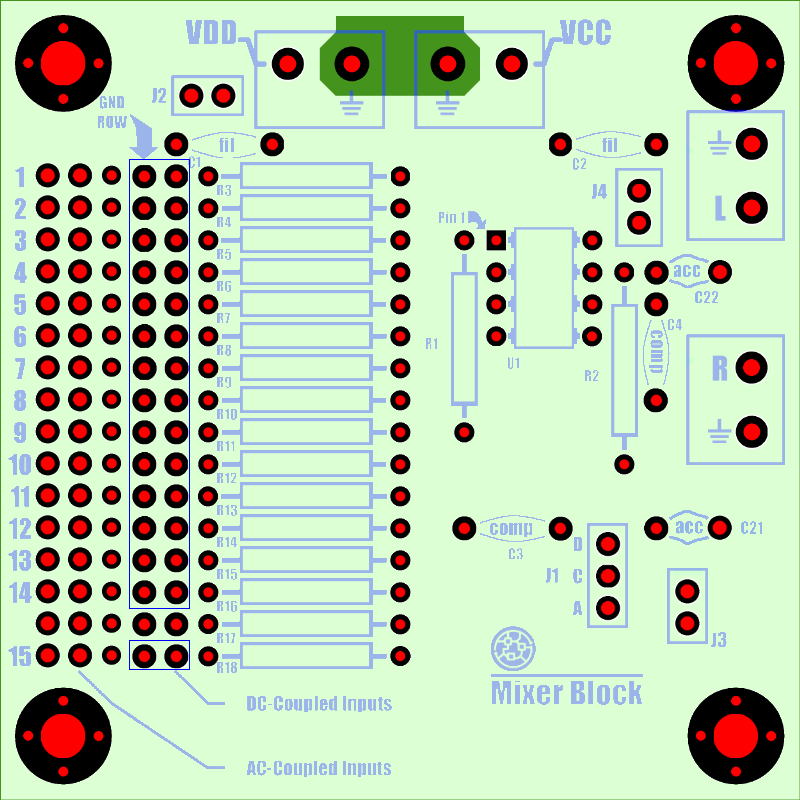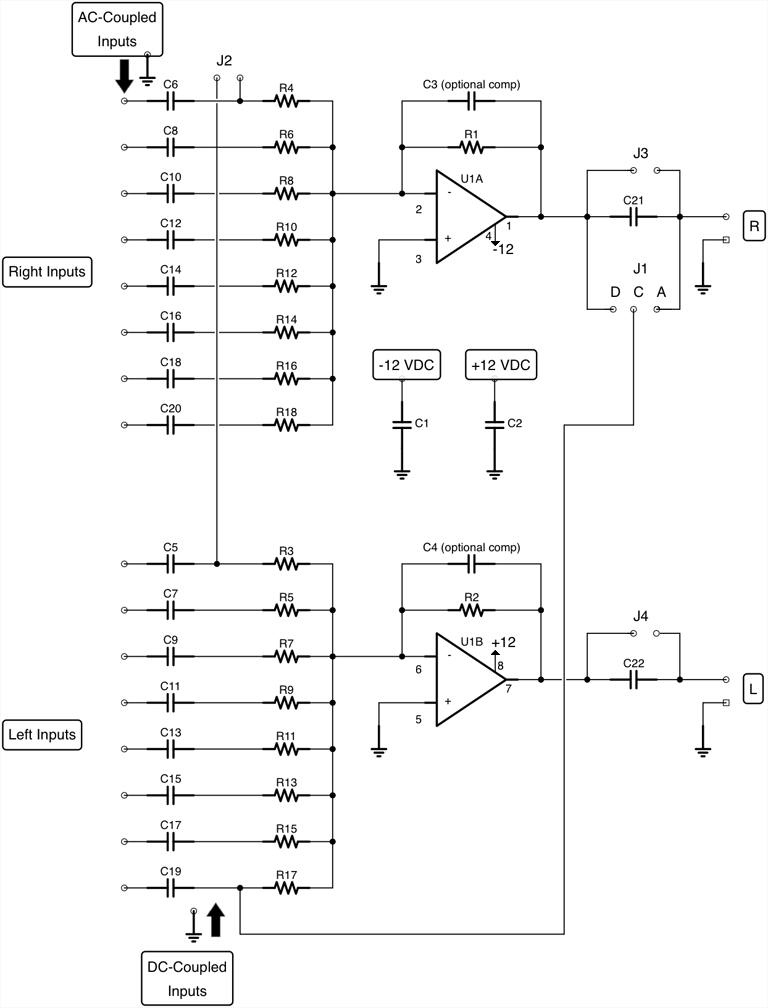§ 3.5 - DC-coupled 15 Channel Mono Mixer
Back to → Main Mixer Block PageBefore you attempt this build, please:
- Read through the numbered build procedure with the idea of performing the listed steps in order
- Examine the PCB layout
- Examine the schematic diagram
- Refer to each of the linked pages in the "See also" list
This will help ensure that you will have the best possible experience, resulting in a build that works the way you expect it to.
This Mixer Block build is a DC-coupled, unity-gain, 15-channel, mono, mixer.
Note: Channels 9 through 15 will be 180° out of phase with channels 1 through 8. Consequently, if using two of this build to mix stereo sources, make sure that stereo signals are connected to identical channel numbers; if a stereo signal is out of left-to-right phase, unwanted signal cancellation can occur.
For the same reason, if using this build to mix stereo signals down to mono, make sure that the left and right channels are both in one of the two groups 1—8, or 9—15.
For the same reason, if using this build to mix stereo signals down to mono, make sure that the left and right channels are both in one of the two groups 1—8, or 9—15.
It has fifteen signal inputs, and one buffered output of those signals on the L output.
Input impedance of this mixer build is 10 k-ohms.
Tip: To power this build of the Mixer Block with the Power Block, use a +/- 15 volt regulated Power Block build. If this is all you'll be powering, you won't need heat sinks on the Power Block, as the power requirements for the Mixer Block are very low.
Tip: In order to reduce the possibility of clipping, you can use a Linear Technology LT1462 opamp with +/- 20 volt power supplies. Odds are that this won't clip even with a TLO72 or TLO82 and +/- 15 volt supplies, but technically speaking, it is possible:
If 12 or more inputs reach line-level in-phase with each other, the output will be driven to the rails with a 15 volt supply. All fifteen inputs, in-phase at line-level will attempt to drive the output to 18.45 volts, and it is this condition that the Linear Technology LT1462 with +/- 20 volt supplies will handle much better than the run of the mill op-amp with 15 volt power rails.
If you know your inputs will rarely or never reach peaks in phase, a TOL72, TLO82, or compatible with +/- 15 volt power rails should be fine.
If 12 or more inputs reach line-level in-phase with each other, the output will be driven to the rails with a 15 volt supply. All fifteen inputs, in-phase at line-level will attempt to drive the output to 18.45 volts, and it is this condition that the Linear Technology LT1462 with +/- 20 volt supplies will handle much better than the run of the mill op-amp with 15 volt power rails.
If you know your inputs will rarely or never reach peaks in phase, a TOL72, TLO82, or compatible with +/- 15 volt power rails should be fine.
Build Steps:
- C1—C2: .1 uF ceramic capacitor
-
C3—C4 optional: ceramic capacitors, only needed for op-amps that require compensation;
TLO-72 and TLO-82 op-amps do not require compensation. Refer to the specific op-amp's datasheet for design values - C21—C22: 10 uF ceramic or other non-polarized capacitor
- Choose Unity Gain Buffer or Gain Amplifier build, then:
- R3—R4: 10 k-ohms 1/8th watt resistors
- U1: LT1462 recommended, but you can also use a TLO-72 low-noise op-amp, can substitute TLO-82, or similar. See tips above. Observe polarity. An IC socket is strongly recommended.
- Install 3-pin jumper J1 — use .100 inch (2.54 mm) header pins; close D to C with a header jumper cap
- Install 2-pin jumper J2 — use .100 inch (2.54 mm) header pins; do not close
- Install 2-pin jumper J3 — use .100 inch (2.54 mm) header pins; close with a header jumper cap
- Install 2-pin jumper J4 — use .100 inch (2.54 mm) header pins; close with a header jumper cap
- If you will be using a 16- or 32-pin input connector, mount it now at the dark blue box at the left; otherwise, connect the input and signal ground wires now
- Install connectors, quantity 4, optional: 5.08mm (.200 in) Spacing, 2-pin PCB Mount Screw Terminal Blocks. Or you can just wire the output from the indicated connections.
- Lastly, install M3 mounting hardware at all 4 mount points
Tip: If you would like to AC-couple the output while retaining the DC input coupling, remove the jumper cap from J4.
| See also: | Recommended Tools Mounting to Wood Surfaces Mixer Block Parts Sources Wiring to Terminal Blocks |
Have a question? Ask us via email
Website Keyboard Navigation
, Previous Page . Next Page
o Ordering g Glossary s Sitemap u Updates
, Previous Page . Next Page
o Ordering g Glossary s Sitemap u Updates

